Abstract
Previous studies have shown that serum interferon (IFN) production in mice is quantitatively influenced by If loci, whose alleles determine high or low production. Although different loci influence IFN production in response to different inducers, such as Newcastle disease virus, Sendai virus, herpes simplex virus type 1, and polyriboinosinic-polyribocytidylic acid, BALB/c mice are in every instance low producers. It was therefore possible that, in addition to If loci, some feature of the BALB/c structural IFN genes contributed to low production. This was examined in the present work, in which IFN production was measured in two strains of C57BL/6 mice congenic with BALB/c at the murine alpha IFN (IFN-alpha) gene cluster on chromosome 4. One line, HW13 (B6.C-H-15c-H-16c-H-20c-H-21c/By) has a BALB/c fragment on chromosome 4 of at least 35 centimorgans which includes the BALB/c IFN-alpha gene cluster and four loci of the brown histocompatibility complex; the other line, HW13J (B6.C-H-15c/By), has a much shorter fragment (about 15 centimorgans), but it also comprises the BALB/c IFN-alpha gene cluster. We show that these mice, carrying the BALB/c IFN-alpha structural genes on a C57BL/6 background, are high IFN producers when stimulated by Newcastle disease virus, Sendai virus, herpes simplex virus type 1, or polyriboinosinic-polyribocytidylic acid. Thus, the low IFN production of BALB/c mice is not directly due to some feature of the IFN-alpha structural genes but is mainly the result of different alleles at If loci.
Full text
PDF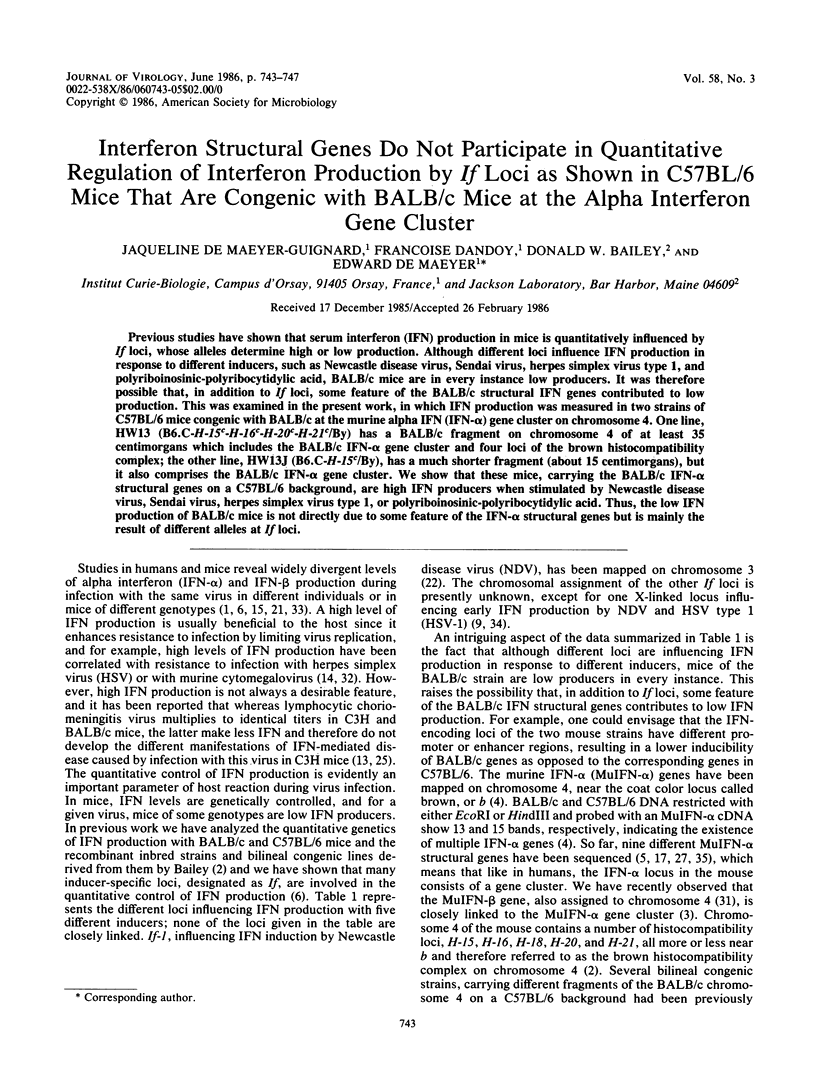
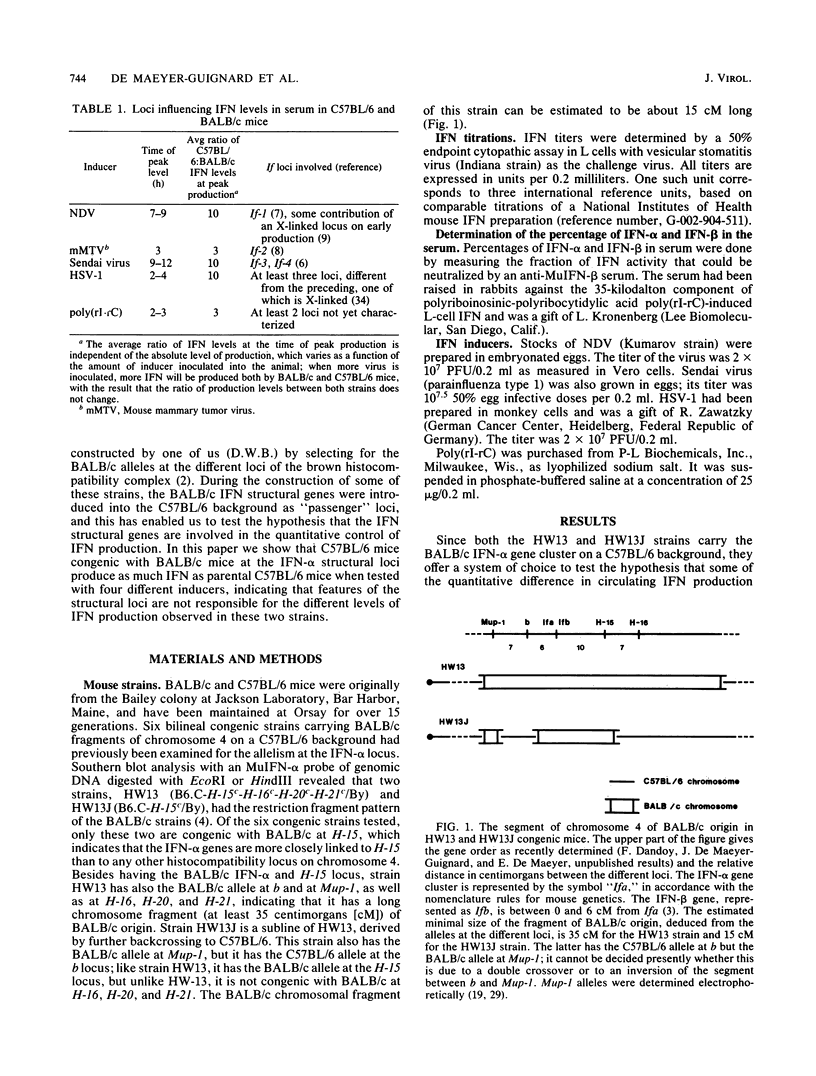
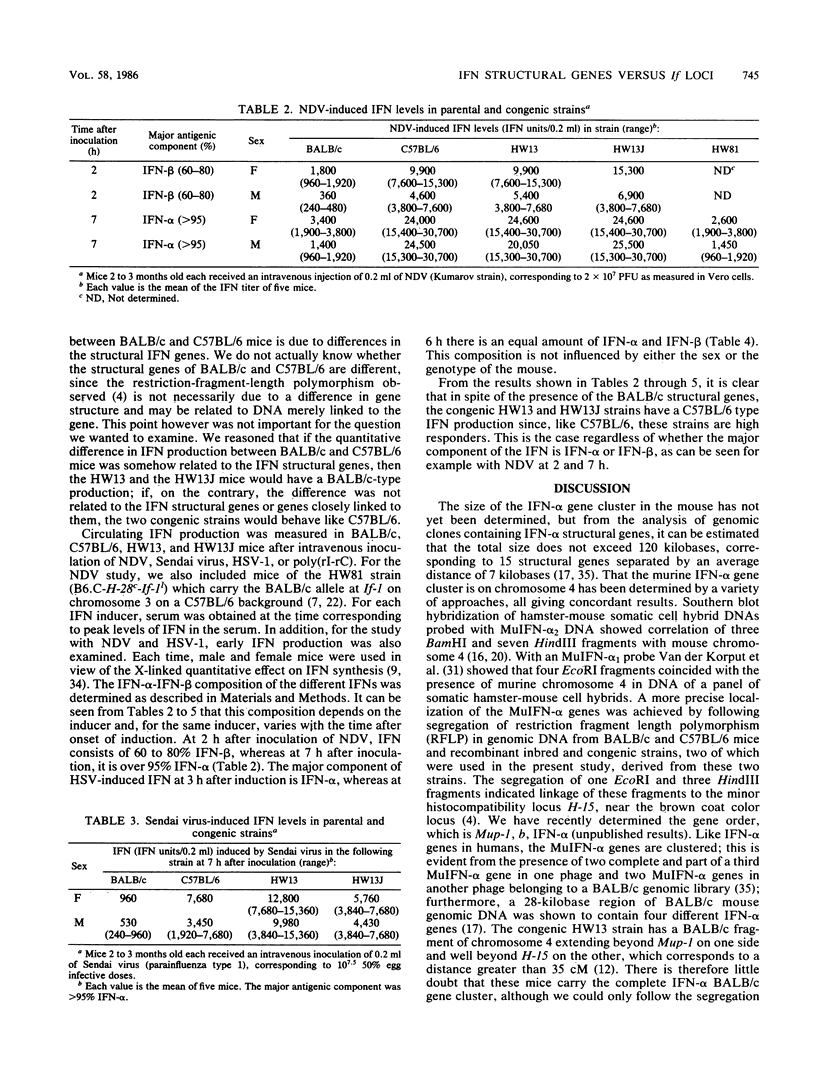
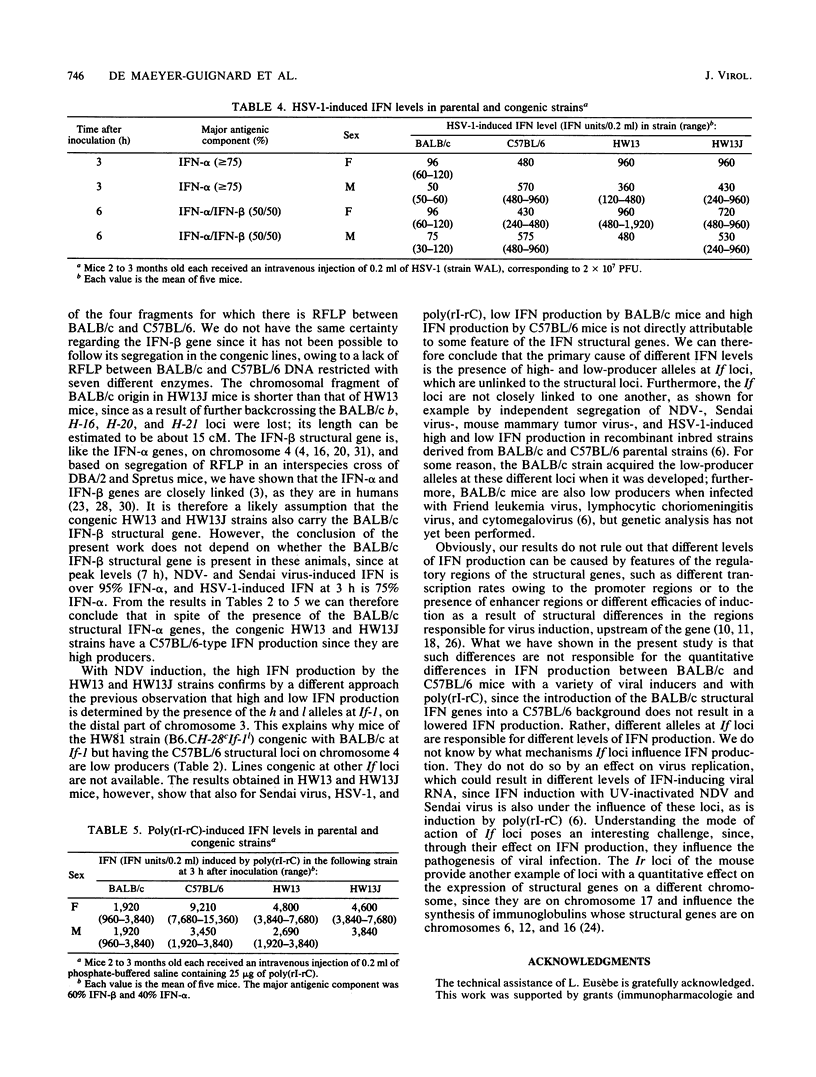
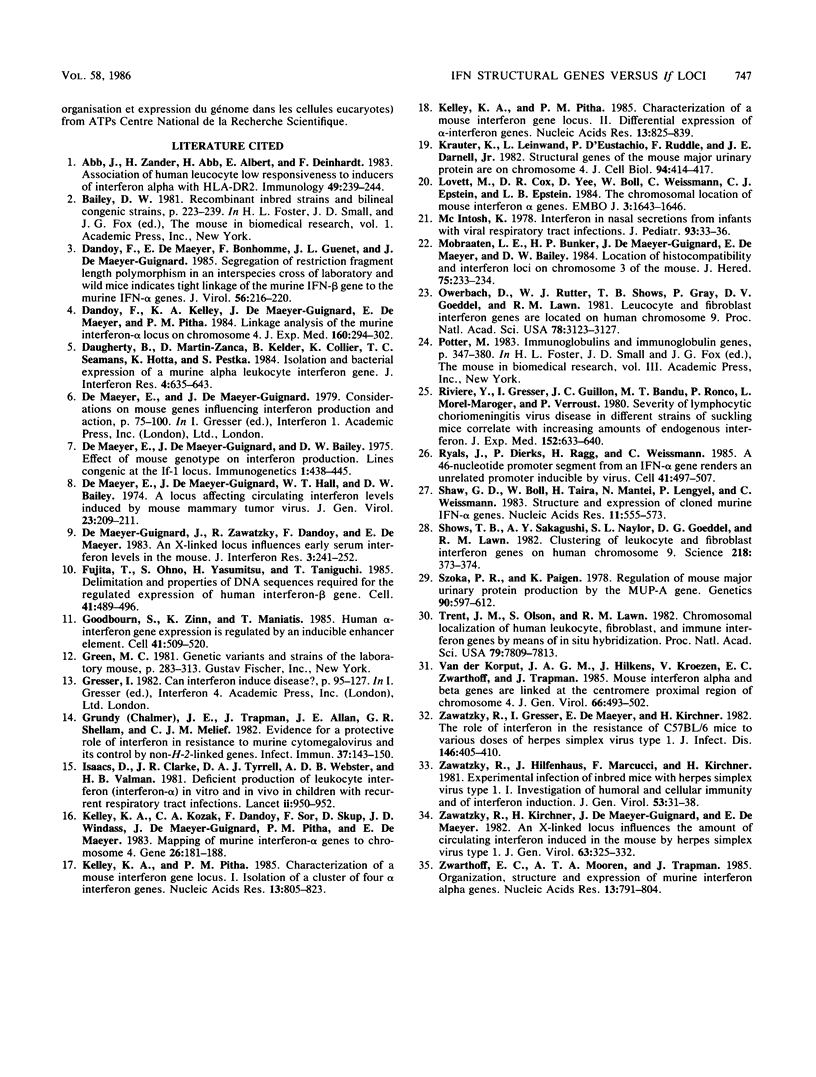
Selected References
These references are in PubMed. This may not be the complete list of references from this article.
- Abb J., Zander H., Abb H., Albert E., Deinhardt F. Association of human leucocyte low responsiveness to inducers of interferon alpha with HLA-DR 2. Immunology. 1983 Jun;49(2):239–244. [PMC free article] [PubMed] [Google Scholar]
- Dandoy F., De Maeyer E., Bonhomme F., Guenet J. L., De Maeyer-Guignard J. Segregation of restriction fragment length polymorphism in an interspecies cross of laboratory and wild mice indicates tight linkage of the murine IFN-beta gene to the murine IFN-alpha genes. J Virol. 1985 Oct;56(1):216–220. doi: 10.1128/jvi.56.1.216-220.1985. [DOI] [PMC free article] [PubMed] [Google Scholar]
- Dandoy F., Kelley K. A., DeMaeyer-Guignard J., DeMaeyer E., Pitha P. M. Linkage analysis of the murine interferon-alpha locus on chromosome 4. J Exp Med. 1984 Jul 1;160(1):294–302. doi: 10.1084/jem.160.1.294. [DOI] [PMC free article] [PubMed] [Google Scholar]
- Daugherty B., Martin-Zanca D., Kelder B., Collier K., Seamans T. C., Hotta K., Pestka S. Isolation and bacterial expression of a murine alpha leukocyte interferon gene. J Interferon Res. 1984 Fall;4(4):635–643. doi: 10.1089/jir.1984.4.635. [DOI] [PubMed] [Google Scholar]
- De Maeyer-Guignard J., Zawatzky R., Dandoy F., De Maeyer E. An X-linked locus influences early serum interferon levels in the mouse. J Interferon Res. 1983;3(2):241–252. doi: 10.1089/jir.1983.3.241. [DOI] [PubMed] [Google Scholar]
- Fujita T., Ohno S., Yasumitsu H., Taniguchi T. Delimitation and properties of DNA sequences required for the regulated expression of human interferon-beta gene. Cell. 1985 Jun;41(2):489–496. doi: 10.1016/s0092-8674(85)80022-2. [DOI] [PubMed] [Google Scholar]
- Goodbourn S., Zinn K., Maniatis T. Human beta-interferon gene expression is regulated by an inducible enhancer element. Cell. 1985 Jun;41(2):509–520. doi: 10.1016/s0092-8674(85)80024-6. [DOI] [PubMed] [Google Scholar]
- Gresser I. Can interferon induce disease? Interferon. 1982;4:95–127. [PubMed] [Google Scholar]
- Grundy J. E., Trapman J., Allan J. E., Shellam G. R., Melief C. J. Evidence for a protective role of interferon in resistance to murine cytomegalovirus and its control by non-H-2-linked genes. Infect Immun. 1982 Jul;37(1):143–150. doi: 10.1128/iai.37.1.143-150.1982. [DOI] [PMC free article] [PubMed] [Google Scholar]
- Isaacs D., Clarke J. R., Tyrrell D. A., Webster A. D., Valman H. B. Deficient production of leucocyte interferon (interferon-alpha) in vitro and in vivo in children with recurrent respiratory tract infections. Lancet. 1981 Oct 31;2(8253):950–952. doi: 10.1016/s0140-6736(81)91153-3. [DOI] [PubMed] [Google Scholar]
- Kelley K. A., Kozak C. A., Dandoy F., Sor F., Skup D., Windass J. D., DeMaeyer-Guignard J., Pitha P. M., DeMaeyer E. Mapping of murine interferon-alpha genes to chromosome 4. Gene. 1983 Dec;26(2-3):181–188. doi: 10.1016/0378-1119(83)90188-9. [DOI] [PubMed] [Google Scholar]
- Kelley K. A., Pitha P. M. Characterization of a mouse interferon gene locus I. Isolation of a cluster of four alpha interferon genes. Nucleic Acids Res. 1985 Feb 11;13(3):805–823. doi: 10.1093/nar/13.3.805. [DOI] [PMC free article] [PubMed] [Google Scholar]
- Kelley K. A., Pitha P. M. Characterization of a mouse interferon gene locus II. Differential expression of alpha-interferon genes. Nucleic Acids Res. 1985 Feb 11;13(3):825–839. doi: 10.1093/nar/13.3.825. [DOI] [PMC free article] [PubMed] [Google Scholar]
- Krauter K., Leinwand L., D'Eustachio P., Ruddle F., Darnell J. E., Jr Structural genes of the mouse major urinary protein are on chromosome 4. J Cell Biol. 1982 Aug;94(2):414–417. doi: 10.1083/jcb.94.2.414. [DOI] [PMC free article] [PubMed] [Google Scholar]
- Lovett M., Cox D. R., Yee D., Boll W., Weissmann C., Epstein C. J., Epstein L. B. The chromosomal location of mouse interferon alpha genes. EMBO J. 1984 Jul;3(7):1643–1646. doi: 10.1002/j.1460-2075.1984.tb02023.x. [DOI] [PMC free article] [PubMed] [Google Scholar]
- Mobraaten L. E., Bunker H. P., DeMaeyer-Guignard J., DeMaeyer E., Bailey D. W. Location of histocompatibility and interferon loci on chromosome 3 of the mouse. J Hered. 1984 May-Jun;75(3):233–234. doi: 10.1093/oxfordjournals.jhered.a109921. [DOI] [PubMed] [Google Scholar]
- Owerbach D., Rutter W. J., Shows T. B., Gray P., Goeddel D. V., Lawn R. M. Leukocyte and fibroblast interferon genes are located on human chromosome 9. Proc Natl Acad Sci U S A. 1981 May;78(5):3123–3127. doi: 10.1073/pnas.78.5.3123. [DOI] [PMC free article] [PubMed] [Google Scholar]
- Rivière Y., Gresser I., Guillon J. C., Bandu M. T., Ronco P., Morel-Maroger L., Verroust P. Severity of lymphocytic choriomeningitis virus disease in different strains of suckling mice correlates with increasing amounts of endogenous interferon. J Exp Med. 1980 Sep 1;152(3):633–640. doi: 10.1084/jem.152.3.633. [DOI] [PMC free article] [PubMed] [Google Scholar]
- Ryals J., Dierks P., Ragg H., Weissmann C. A 46-nucleotide promoter segment from an IFN-alpha gene renders an unrelated promoter inducible by virus. Cell. 1985 Jun;41(2):497–507. doi: 10.1016/s0092-8674(85)80023-4. [DOI] [PubMed] [Google Scholar]
- Shaw G. D., Boll W., Taira H., Mantei N., Lengyel P., Weissmann C. Structure and expression of cloned murine IFN-alpha genes. Nucleic Acids Res. 1983 Feb 11;11(3):555–573. doi: 10.1093/nar/11.3.555. [DOI] [PMC free article] [PubMed] [Google Scholar]
- Shows T. B., Sakaguchi A. Y., Naylor S. L., Goedell D. V., Lawn R. M. Clustering of leukocyte and fibroblast interferon genes of human chromosome 9. Science. 1982 Oct 22;218(4570):373–374. doi: 10.1126/science.6181564. [DOI] [PubMed] [Google Scholar]
- Szoka P. R., Paigen K. Regulation of mouse major urinary protein production by the Mup-A gene. Genetics. 1978 Nov;90(3):597–612. doi: 10.1093/genetics/90.3.597. [DOI] [PMC free article] [PubMed] [Google Scholar]
- Trent J. M., Olson S., Lawn R. M. Chromosomal localization of human leukocyte, fibroblast, and immune interferon genes by means of in situ hybridization. Proc Natl Acad Sci U S A. 1982 Dec;79(24):7809–7813. doi: 10.1073/pnas.79.24.7809. [DOI] [PMC free article] [PubMed] [Google Scholar]
- Zawatzky R., Gresser I., DeMaeyer E., Kirchner H. The role of interferon in the resistance of C57BL/6 mice to various doses of herpes simplex virus type 1. J Infect Dis. 1982 Sep;146(3):405–410. doi: 10.1093/infdis/146.3.405. [DOI] [PubMed] [Google Scholar]
- Zawatzky R., Hilfenhaus J., Marcucci F., Kirchner H. Experimental infection of inbred mice with herpes simplex virus type 1. I. Investigation of humoral and cellular immunity and of interferon induction. J Gen Virol. 1981 Mar;53(Pt 1):31–38. doi: 10.1099/0022-1317-53-1-31. [DOI] [PubMed] [Google Scholar]
- Zawatzky R., Kirchner H., DeMaeyer-Guignard J., DeMaeyer E. An X-linked locus influences the amount of circulating interferon induced in the mouse by herpes simplex virus type 1. J Gen Virol. 1982 Dec;63(2):325–332. doi: 10.1099/0022-1317-63-2-325. [DOI] [PubMed] [Google Scholar]
- Zwarthoff E. C., Mooren A. T., Trapman J. Organization, structure and expression of murine interferon alpha genes. Nucleic Acids Res. 1985 Feb 11;13(3):791–804. doi: 10.1093/nar/13.3.791. [DOI] [PMC free article] [PubMed] [Google Scholar]
- de Maeyer E., de Maeyer-Guignard J., Hall W. T., Bailey D. W. A locus affecting circulating interferon levels induced by mouse mammary tumour virus. J Gen Virol. 1974 May;23(2):209–211. doi: 10.1099/0022-1317-23-2-209. [DOI] [PubMed] [Google Scholar]
- van der Korput J. A., Hilkens J., Kroezen V., Zwarthoff E. C., Trapman J. Mouse interferon alpha and beta genes are linked at the centromere proximal region of chromosome 4. J Gen Virol. 1985 Mar;66(Pt 3):493–502. doi: 10.1099/0022-1317-66-3-493. [DOI] [PubMed] [Google Scholar]


